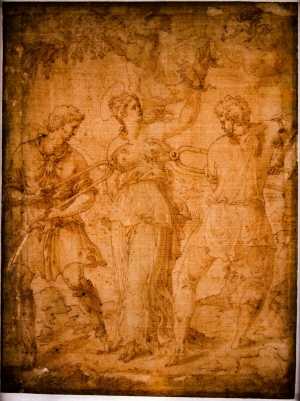Specifications
| Title | The Martyrdom of St Agatha |
|---|---|
| Material and technique | Pen and brown ink, brown wash, incised |
| Object type |
Drawing
> Two-dimensional object
> Art object
|
| Location | This object is in storage |
| Dimensions |
Height 277 mm Width 207 mm |
|---|---|
| Artists |
Draughtsman:
Giulio Clovio
|
| Accession number | L 1951/T 10 (PK) |
| Credits | From the estate of Dr J.C.J. Bierens de Haan, 1951 |
| Department | Drawings & Prints |
| Acquisition date | 1951 |
| Creation date | in circa 1567 |
| Watermark | Lamb in circle (45 x 47 mm, on P3 of 6P, vH, left), similar to Briquet 49 (with halo)(Florence 1511, Treviso 1514), similar to Piccard Online 86768 (Ferrara 1576) |
| Mark | Van Parijs (L.2531, no. 8) |
| Provenance | Van Parijs (rond 1800, L.2531, no. 8), Brussels; his sale Amsterdam (Muller) 11-12.01.1878, lot 117 (Vasari, with the etching by C. Cort, Fl 3); - ; art dealerJ.H.J. Mellaart, London-The Hague-Borgharen; Dr. J.C.J. Bierens de Haan, Amsterdam, acquired 1941; Bequest Dr. J.C.J. Bierens de Haan 1951 |
| Exhibitions | Rotterdam 2010 (coll 2 kw 7) |
| Internal exhibitions |
De Collectie Twee - wissel VII, Prenten & Tekeningen (2010) |
| Research |
Show research Italian Drawings 1400-1600 |
| Literature | Bierens de Haan 1948, p. 130, no. 120, ill. 35; Zagreb 1998, pp. 76-77 |
| Material | |
| Object | |
| Technique |
Washing
> Wash
> Drawing technique
> Technique
> Material and technique
Washing
> Wash
> Drawing technique
> Technique
> Material and technique
|
| Geographical origin | Italy > Southern Europe > Europe |
Do you have corrections or additional information about this work? Please, send us a message


























